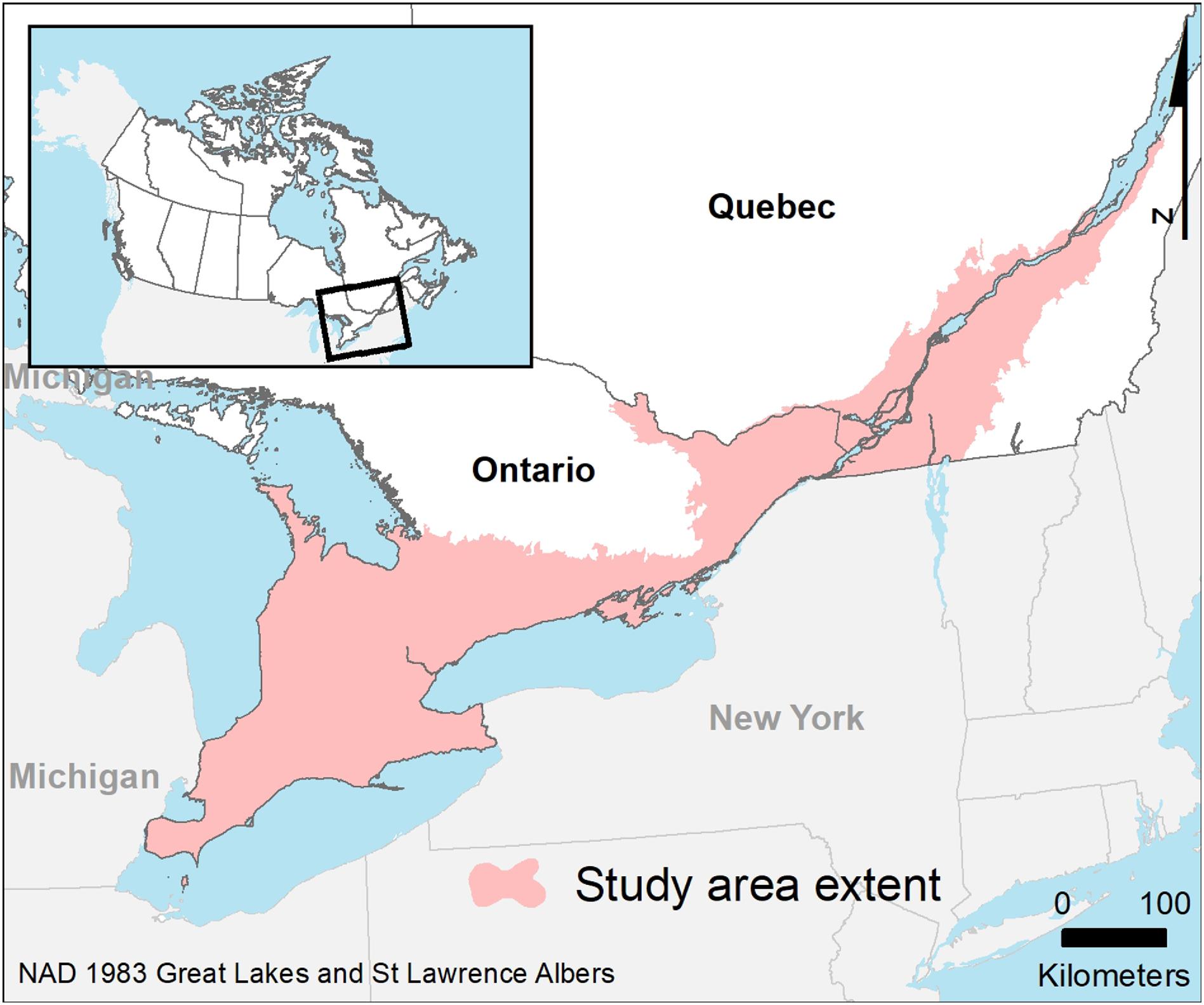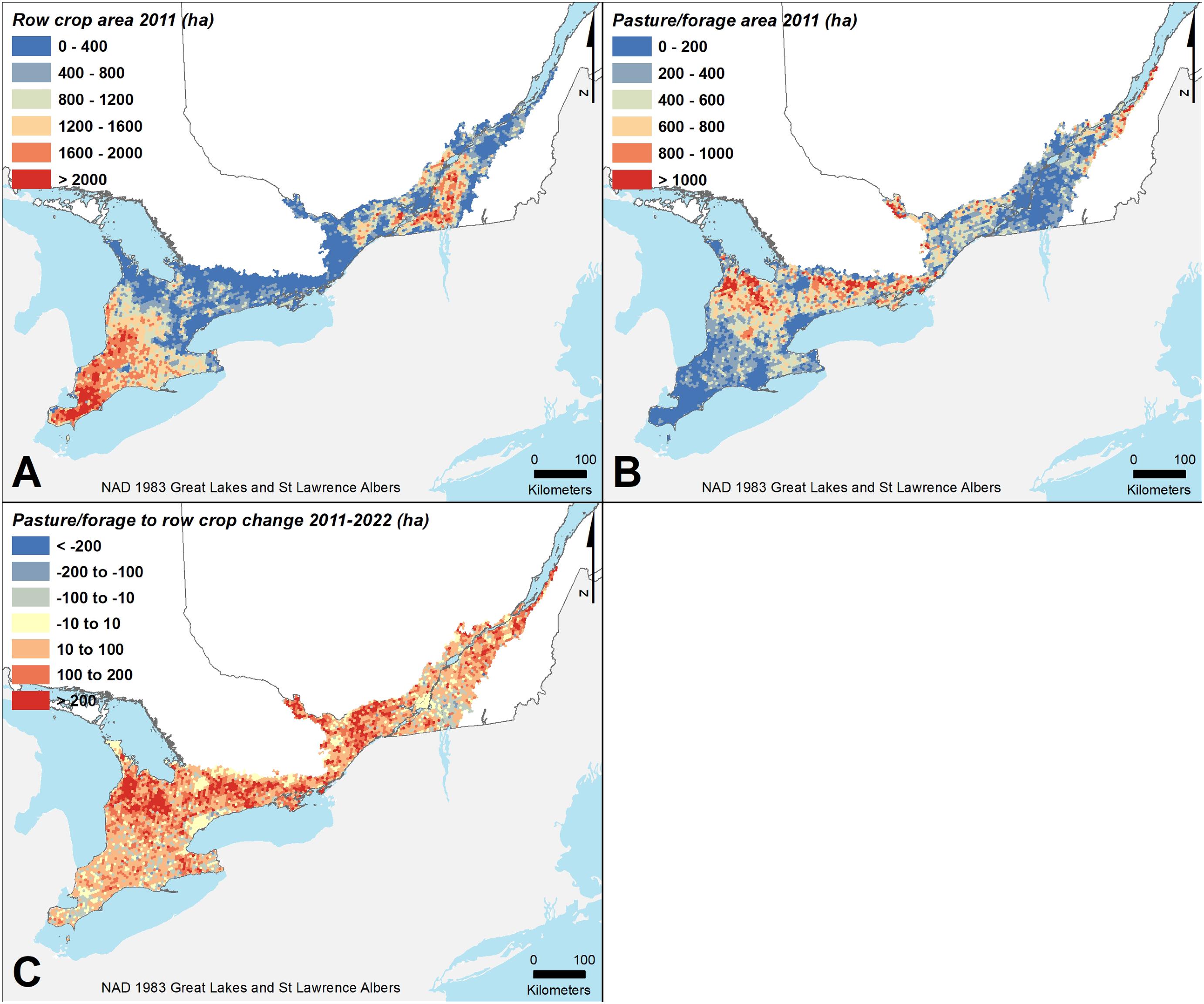1. Introduction
The agricultural landscape in Canada changed dramatically over the last half of the 20th century, shifting from extensive to more intensive agriculture, as global agricultural industrialization drove improvements in mechanization, plant breeding, farm consolidation, irrigation, increased use of nutrients and pesticides, and shifts to intense livestock management (
Parson 1999). While these changes have vastly increased the productivity of farmland, they have come at a cost to environmental sustainability. For example, advances in plant breeding have made it possible to grow crops such as soy at more northerly latitudes (
Government of Canada 2017), expanding the area of native habitat that could be converted to farmland; an estimated 65%–70% of Canada’s suitable agricultural lands were converted from natural areas by the 21st century (
Gauthier and Wiken 2003).
Agricultural intensification is recognized globally as a significant driver of biodiversity loss (
Dudley and Alexander 2017;
FAO 2019,
2020;
IPBES 2019) and wildlife distributions (
Fontaine et al. 2017), suggesting that changes to on-farm practices and agricultural policies may have important wildlife conservation effects. We use publicly available spatial data to measure recent changes in agricultural land use in Canada’s Mixedwood Plains Ecozone to estimate native biodiversity impacts.
Canada’s Mixedwood Plains Ecozone extends from its southern and western edges in Ontario along Lakes Huron, Erie, and Ontario, and the St. Lawrence River and extends into southern portions of Quebec along the St. Lawrence lowlands (
Crins et al. 2009). Agriculture is the dominant land cover, comprising 55% of the land area (calculated from
Natural Resources Canada (2020) not including open water). As a result, the ecozone is one of Canada’s main agricultural regions and it contains 34% of Canada’s farms (based on intersecting Census of Agriculture consolidated subdivisions;
Statistics Canada 2021a) and 14% of Canada’s farmland (calculated from
Natural Resources Canada 2020). The region accounts for the majority of Canada’s corn, soy, and dairy production (
Statistics Canada 2018,
2021a,
2023). The Mixedwood Plains Ecozone is also densely settled—home to approximately 20.1 million people in 2021, an increase of 10.4% since 2011 (
Statistics Canada 2021b,
2022a).
Despite the high level of human disturbance in the Mixedwood Plains Ecozone, it remains an ecologically diverse area of Canada where remnant forests and wetlands provide habitat for thousands of plant and animal species. Historically the ecozone was a mosaic of forests, wetlands, alvars, freshwater ecosystems, and, in the southwest, tallgrass prairies and savannahs (
Crins et al. 2009), most of which have been converted to urban and agricultural lands (
Natural Resources Canada 2020). Tallgrass prairie and savannah habitat are among the most threatened and rare ecosystems within the ecozone and are estimated to currently cover less than 3% (as of 1992) of their historic extent (
Environment Canada 2010). These prairies and savannahs would likely have been habitat for many grassland specialists that as native grassland habitat was converted, likely either disappeared from the landscape or adapted to using suitable farmland. At present, with the near-total loss of native grassland habitat in the ecozone, grassland species that rely on suitable farmland habitat such as pastures and hay fields face a renewed threat from the decline of perennial crops.
The Eastern Meadowlark (
Sturnella magna (Linnaeus, 1758)) is one such grassland species that inhabited the tallgrass prairies of the Mixedwood Plains Ecozone prior to European arrival (
Askins 1999). Meadowlarks were able to benefit from the expansion of pastures and hay fields across southern Ontario and Quebec during the 19th century, but are currently in decline (
COSEWIC 2011) and listed as Threatened by Canada’s Species at Risk Act and Ontario’s Endangered Species Act. Declines have been primarily attributed to habitat loss by means of conversion of pastures and hay fields to row crops, reforestation, urbanization, earlier and more frequent mowing of hay, predation and parasitism, habitat fragmentation, and pesticide use (
COSEWIC 2011). The lack of remaining native habitat in the ecozone means Eastern Meadowlarks face regional extirpation if suitable farmland habitat is not conserved or grassland habitat restored.
Data from Statistics Canada’s Census of Agriculture show that farmland area in Ontario and Quebec has decreased from 8.5 million ha in 2011 to 7.9 million ha in 2021 (
Statistics Canada 2022b), the equivalent of losing 154 ha of farmland per day. This oft-cited farmland loss has been primarily attributed to the increasing human population and associated urban sprawl (
AgMedia Inc. 2014;
Ontario Farmland Trust 2022;
CBC News 2023). Similarly, the Institut de la statistique du Québec reported a loss of 440 000 ha of farmland in Quebec during the 2000s and 2010s (
Institut de la statistique du Québec 2023). Historical census data reveal that this trend is not new, with the total farmland area having declined by 44% in Ontario from the 1920s to the 2000s and 51% in Quebec from the 1950s to the 2010s and the number of farms having declined by 74% in Ontario and 78% in Quebec during the same time periods (
Smith 2015;
Ruiz 2019).
Smith (2015) also showed that, in Ontario, the overall cropland area has been stable since the 1920s but that conversion from perennial pastures to annual crops has occurred. However, the Census of Agriculture reports farmland area as all lands on farms, including wetlands and forests, rather than lands actively in use for agriculture, thus obscuring habitat conversion. When lands not actively in use for agriculture are removed, the census shows a more moderate loss of 98 000 ha—from 5.9 million ha in 2011 to 5.8 million ha in 2021, or 27 ha per day in Ontario and Quebec. The census data also do not inform the dynamics among agriculture and other land cover types, such as urban lands, forest, and wetlands. We aimed to address the shortcomings of the Census of Agriculture data by assessing agricultural land change in the Mixedwood Plains Ecozone using land cover datasets derived from remotely sensed data. Previous studies have also examined land change in the Quebec portion of the Mixedwood Plains Ecozone using remotely sensed data or aerial photographs (
Jobin et al. 2010,
2014;
Dauphin and Jobin 2016;
Drapeau et al. 2019). However, the most recent study periods were from 1993 to 2001 (
Jobin et al. 2010) and 1993 to 2014 (
Drapeau et al. 2019); the former assessed land use and relative change at an ecoregion scale and land change dynamics at a 1 km resolution, while the latter assessed agricultural land change at a bioclimatic zone scale, similar to the ecoregion scale.
The ability to assess land cover using remotely sensed data has improved in recent years. Multiple publicly available land cover datasets are available in Canada that identify agricultural land as well as distinguish among types of agriculture. We used the best available datasets to assess land cover change with respect to the agricultural landscape in the Mixedwood Plains Ecozone. We quantified the shift from perennial pasture and forage (hereafter referred to as pasture/forage) to annual row crops as well as conversion from agriculture to and from other land cover types. We hypothesize that the shifting agricultural landscape affects biodiversity and provide a case study quantifying the potential implications on the threatened Eastern Meadowlark population, comparing modelled carrying capacity to changes in abundance reported by a breeding bird atlas.




